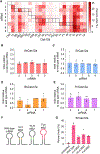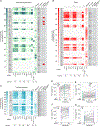Harnessing noncanonical crRNAs to improve functionality of Cas12a orthologs
- PMID: 38358883
- PMCID: PMC11031708
- DOI: 10.1016/j.celrep.2024.113777
Harnessing noncanonical crRNAs to improve functionality of Cas12a orthologs
Abstract
There is a broad diversity among Cas12a endonucleases that possess nucleic acid detection and gene-editing capabilities, but few are studied extensively. Here, we present an exhaustive investigation of 23 Cas12a orthologs, with a focus on their cis- and trans-cleavage activities in combination with noncanonical crRNAs. Through biochemical assays, we observe that some noncanonical crRNA:Cas12a effector complexes outperform their corresponding wild-type crRNA:Cas12a. Cas12a can recruit crRNA with modifications such as loop extensions and split scaffolds. Moreover, the tolerance of Cas12a to noncanonical crRNA is also observed in mammalian cells through the formation of indels. We apply the adaptability of Cas12a:crRNA complexes to detect SARS-CoV-2 in clinical nasopharyngeal swabs, saliva samples, and tracheal aspirates. Our findings further expand the toolbox for next-generation CRISPR-based diagnostics and gene editing.
Keywords: CP: Molecular biology; CRISPR-Cas; CRISPR-Cas12a; Cas12a orthologs; SARS-CoV-2; cCRISPR; clinical diagnostics; combinatorial CRISPR-Cas; gene editing; non-canonical crRNA; nucleic acid detection.
Published by Elsevier Inc.
Conflict of interest statement
Declaration of interests P.K.J. and L.T.N. are listed as inventors on patent applications related to the content of this work. Provisional patents (63/222,251 and 63/191,647) have been filed covering the methods and compositions of combinatorial CRISPR-Cas complexes. P.K.J. is a cofounder of Genable Biosciences LLC, Par Biosciences LLC, and CRISPR LLC.
Figures





References
Publication types
MeSH terms
Substances
Grants and funding
LinkOut - more resources
Full Text Sources
Research Materials
Miscellaneous

